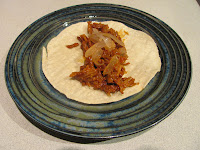Banana bread rarely needs an occasion. Whether using up some extra ripe bananas or satisfying a craving, bake a loaf or two up and people seem to line up for their share. If you don't have ripe bananas around, I find that slow roasting them in the skins brings out the sweetness you're looking for, and actually keeps them from browning during the baking process, giving you a paler loaf for a nice change.
You will need:
454g / 1lb ripe bananas
454g / 1lb brown sugar
2 eggs
250ml / 1C canola oil
250ml / 1C milk (homo is best)
454g / 1lb pastry flour
14g / 1/2oz baking soda
pinch salt
as needed butter or pan spray
Method:
- set the oven to 350F / 177C
- butter or pan spray two standard loaf pans (to stick the paper)
- line the pans with parchment paper
- mash the bananas
- in a mixer with a paddle, mix the bananas and brown sugar
- lightly beat the eggs and add to the mix
- sift flour, baking soda and salt together
- combine the milk and oil
- add the wet and dry mixes alternately in 3 stages, finishing with the last of the dry
- divide the mix between the two pans
- bake at 350F / 177C for 45 minutes to an hour until a skewer comes out clean
- cool on a rack
- to unmold, gently run a knife around the edge of the pan anywhere not covered by paper and turn out











